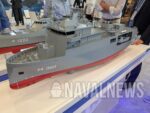At the AUSA 2025 exposition in Washington D.C., Sikorsky (a Lockheed Martin company) unveiled its new vertical takeoff and landing (VTOL) unmanned aerial system (UAS), the Nomad. Designed to support multi-domain operations with both intelligence-surveillance-reconnaissance (ISR) and strike capabilities, the Nomad leverages a rotor-blown wing architecture to bridge the gap between helicopter-like agility and fixed-wing endurance.
Rotor-Blown Wing Architecture Enables Efficient Hover-to-Cruise Transition
The standout feature of the Nomad is its use of a rotor-blown wing—a concept that uses propeller wash over fixed wings to enable vertical lift while also contributing to forward flight efficiency. This design allows for compact hover capability without sacrificing aerodynamic performance in cruise mode. The configuration is reminiscent of concepts explored under DARPA’s Advanced AirCraft Infrastructure-Less Launch And Recovery (ANCILLARY) program.
Sikorsky has previously demonstrated expertise in coaxial rotorcraft and hybrid VTOL configurations through programs like X2 and S-97 Raider. The Nomad appears to build on this legacy while adopting a more modular UAS-centric approach. The drone features twin tilting rotors mounted on short-span wings with blown-lift surfaces that provide additional lift during transition phases.
This architecture enables runway-independent operations from confined spaces—such as ship decks or forward operating bases—while offering longer range and loiter time than conventional multirotor drones. According to Sikorsky representatives at AUSA 2025, the aircraft can transition from hover to forward flight within seconds using autonomous controls optimized for contested environments.
Modular Payload Bay Supports ISR, Strike, and Logistics Roles
The Nomad’s mission versatility is enabled by a modular payload bay beneath its fuselage. At AUSA 2025, Sikorsky showcased several interchangeable modules including:
- EO/IR sensor turret for day/night ISR
- Electronic warfare (EW) pod
- Precision-guided munition launcher (likely for AGM-176 Griffin or similar lightweight weapons)
- Small cargo container for resupply missions
This modularity reflects broader U.S. Army interest in multi-role Group III/IV UAS platforms capable of supporting MDO (Multi-Domain Operations). While exact specifications were not disclosed publicly at launch, industry analysts estimate a maximum takeoff weight (MTOW) of approximately 250–300 kg with an endurance of up to six hours depending on payload configuration.
The platform is designed to be reconfigurable in-theater by small teams without specialized tools—an important requirement for expeditionary forces operating under degraded or denied logistics chains.
Autonomy Stack Optimized for Contested Environments
Sikorsky emphasized that the Nomad’s autonomy suite is designed specifically for GPS-denied or EW-contested environments. The aircraft includes onboard visual navigation systems fused with inertial guidance to maintain position even under jamming conditions.
The autonomy stack builds on Lockheed Martin’s investments in AI-enabled flight control software developed under programs like ALIAS (Aircrew Labor In-Cockpit Automation System) and Project Convergence experiments. Key features include:
- Autonomous takeoff/landing from unprepared sites
- Dynamic route re-planning based on threat inputs
- Swarm coordination protocols compatible with other U.S./NATO unmanned systems
This makes the platform suitable not only for ISR but also as part of larger manned-unmanned teaming architectures such as those envisioned under Future Vertical Lift (FVL).
Sikorsky Targets Army Tactical UAS Requirements Beyond Shadow/Tactical Gray Eagle
The Nomad enters a competitive landscape as the U.S. Army seeks replacements or supplements to aging RQ-7 Shadow and MQ-1C Gray Eagle fleets. While Group V HALE systems like MQ-9 Reaper are being adapted for MDO via SATCOM links and AI integration, there remains a critical need at brigade level for runway-independent tactical drones with organic launch/recovery capability.
Sikorsky’s offering aligns closely with these needs—particularly given its ability to operate without dedicated infrastructure or launch rails. It may also compete against other ANCILLARY-derived platforms such as Northrop Grumman’s V-BAT derivatives or Shield AI’s V-BAT X variant.
A key differentiator could be Sikorsky’s deep integration into existing Army aviation programs via UH-60 Black Hawk sustainment contracts and FVL ecosystem participation—potentially easing interoperability hurdles compared to smaller startups or foreign OEMs.
Development Timeline Tied to DARPA ANCILLARY Milestones
The Nomad appears closely tied to DARPA’s ANCILLARY program timeline. In late 2023, DARPA awarded Phase I contracts to multiple vendors including Sikorsky/Lockheed Martin. By mid-2024, downselects had occurred based on wind tunnel testing and subscale demonstrator flights.
The full-scale prototype displayed at AUSA likely represents an early Phase II demonstrator intended for limited operational evaluations starting in FY26. If successful during field trials—including autonomous shipboard landings—the platform could transition into a Program of Record by FY27–28 under Army Futures Command oversight.
No formal procurement quantities have been announced yet; however, sources suggest initial low-rate production could begin by late FY27 if budgeted under PEO Aviation’s Tactical UAS modernization line item.
Conclusion: Rotor-Blown Wing Drones Gain Momentum Across Services
Sikorsky’s unveiling of the Nomad underscores growing military interest in rotor-blown wing architectures that blend vertical agility with fixed-wing efficiency—especially as services seek expeditionary ISR/strike platforms deployable without runways or large logistics tails.
If successfully matured through ANCILLARY trials and adopted by service branches beyond the Army—including Navy expeditionary units—the design could mark a shift toward more versatile Group III/IV drones optimized not just for surveillance but also precision effects delivery within anti-access environments.









